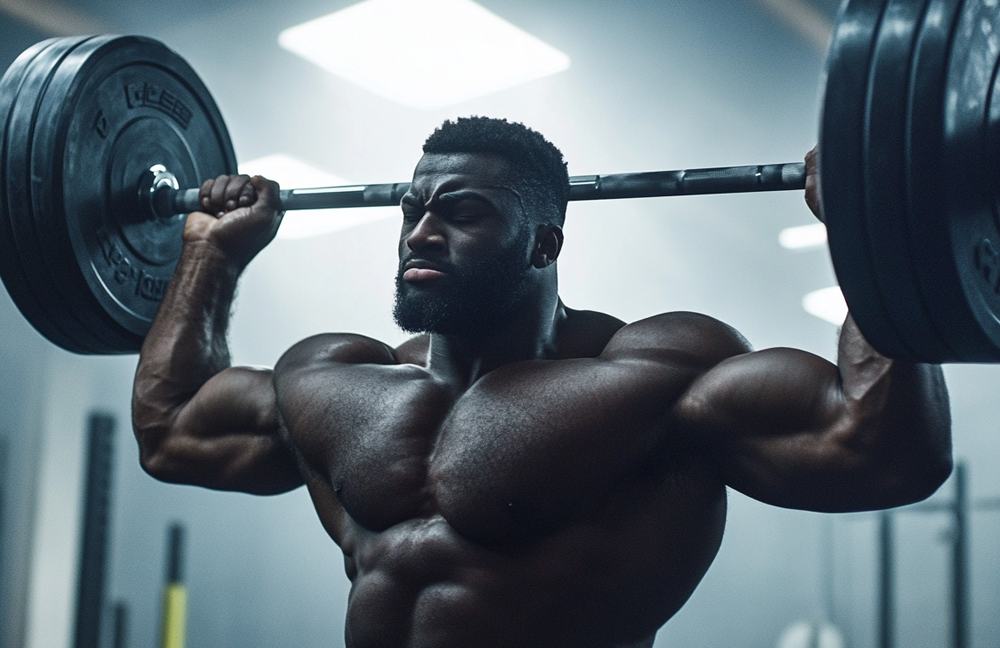Introduction
If you think building muscle and staying strong is only for younger people, think again! Strength training over 50 is one of the most effective ways to maintain muscle, boost metabolism, and stay active for life. Whether you’re a complete beginner or someone looking to get back into weight training, lifting weights can improve strength, prevent injuries, and enhance overall well-being – no matter your age.
As we get older, muscle loss, joint stiffness, and slower metabolism become common challenges. However, research shows that regular strength training can reverse these effects, helping you stay fit, energetic, and pain-free well into your 50s, 60s, and beyond.
In this guide, you’ll learn:
- Why strength training over 50 is essential for muscle retention and fat loss
- The best exercises to build strength while protecting your joints
- How to prevent injuries and recover faster
- Nutritional strategies to fuel your workouts and maintain muscle
- Common mistakes to avoid when training over 50
It’s never too late to start lifting and feeling stronger than ever. Let’s dive in and discover how strength training over 50 can transform your body and health! 💪🔥

1. Why Strength Training Over 50 is Critical for Health & Longevity
Many people assume that once they reach 50, muscle loss, slower metabolism, and joint pain are inevitable. But the truth is, you have more control over your strength, mobility, and overall health than you think. The key? Strength training over 50.
Regular resistance training can slow down aging, prevent common health issues, and keep you moving pain-free for years. Let’s look at the biggest benefits of lifting weights after 50.
1. Prevents Muscle Loss (Sarcopenia) & Keeps You Strong
As we age, we naturally lose muscle mass in a process called sarcopenia. If left unchecked, muscle loss can lead to weakness, poor balance, and reduced mobility.
- Without strength training, adults lose about 3-8% of muscle mass per decade after 30.
- By 50, the rate of muscle loss accelerates, making daily activities harder.
- Lifting weights slows down or reverses sarcopenia, helping you maintain muscle strength.
- More muscle = better mobility, faster metabolism, and greater independence.
💡 Key Takeaway: Strength training keeps you strong and functional as you age.
2. Boosts Metabolism & Helps Burn Fat
One reason many people over 50 gain weight even if they eat the same as before is because muscle burns calories – and without training, muscle mass declines.
- More muscle = a higher resting metabolism, meaning you burn more calories even at rest.
- Strength training helps you burn fat while preserving lean muscle, preventing the “skinny fat” look.
- Lifting weights improves insulin sensitivity, reducing the risk of type 2 diabetes.
Depending on your body type, you might need to adjust your training. Skinny athletes need to train differently than bulky or overweight athletes.
💡 Key Takeaway: More muscle means a faster metabolism and easier fat loss after 50.
3. Strengthens Bones & Reduces Osteoporosis Risk
After 50, bone density decreases, increasing the risk of osteoporosis and fractures. Strength training stimulates bone-building cells, making bones denser and more resistant to breaks.
- Weight-bearing exercises like squats and deadlifts help build stronger bones.
- Strength training reduces the risk of fractures and bone-related injuries.
- Women over 50 benefit the most from weightlifting, as osteoporosis is more common in women.
💡 Key Takeaway: Lifting weights improves bone density, reducing fracture risk and keeping you active.
4. Improves Joint Health & Reduces Pain
Many people worry that lifting weights will hurt their joints—but the opposite is true! Strength training actually strengthens the muscles around your joints, reducing stiffness and pain.
- Stronger muscles = better joint stability and less pressure on knees, hips, and shoulders.
- Lifting with proper form improves mobility, making daily movements easier.
- Studies show weightlifting reduces arthritis symptoms and chronic pain.
💡 Key Takeaway: Proper strength training improves joint stability and reduces pain.
5. Enhances Balance, Coordination & Prevents Falls
Falls are a major concern for adults over 50, leading to serious injuries, fractures, and reduced mobility. Strength training improves:
- Leg & core strength, reducing the risk of falls.
- Balance & coordination by strengthening stabilizing muscles.
- Grip strength, which is linked to overall longevity and independence.
💡 Key Takeaway: A strong body is a stable body -lifting weights helps prevent falls and injuries.
6. Supports Heart Health & Reduces Disease Risk
Lifting weights isn’t just for muscles – it benefits your heart, too. Strength training has been shown to:
- Lower blood pressure & improve circulation.
- Reduce LDL (“bad”) cholesterol while increasing HDL (“good”) cholesterol.
- Lower the risk of heart disease, stroke, and type 2 diabetes.
💡 Key Takeaway: Strength training isn’t just for looking good—it’s for heart health, too.
7. Keeps You Mentally Sharp & Boosts Confidence
- Lifting weights increases blood flow to the brain, improving memory & focus.
- Strength training releases endorphins, reducing stress & improving mood.
- Seeing progress in the gym builds confidence & mental resilience.
💡 Key Takeaway: A strong body leads to a sharp mind and a confident outlook.
8. It’s Never Too Late to Start Strength Training
The best part? It doesn’t matter if you’ve never lifted weights before – you can start at any age. Studies show that even people in their 70s & 80s can build muscle and strength with weight training.
- Strength training improves quality of life at any age.
- It’s never too late to start – progress can be made at any fitness level.
- Start where you are, and keep improving!
💡 Key Takeaway: You can start strength training at any age and see results – it’s never too late!
Final Thoughts: Why Strength Training Over 50 is a Game Changer
- Prevents muscle loss & keeps you strong.
- Boosts metabolism & helps burn fat.
- Strengthens bones & reduces osteoporosis risk.
- Improves joint health & mobility.
- Enhances balance & reduces the risk of falls.
- Lowers heart disease & diabetes risk.
- Sharpens the mind & boosts confidence.
- It’s never too late to start – progress can happen at any age!

2. The Best Strength Training Plan for People Over 50
Now that you understand why strength training over 50 is essential for muscle growth, fat loss, and longevity, it’s time to put together a safe and effective workout plan. The key to getting stronger while avoiding injuries is to focus on:
- Smart training frequency (3-4 times per week)
- The best exercises for strength, balance, and mobility
- Progressive overload (gradual increases in weight and reps)
- Joint-friendly movements that protect your knees, shoulders, and lower back
Step 1: How Often Should You Strength Train?
For people over 50, training 3-4 times per week is the sweet spot for building strength while allowing proper recovery.
🏋️ Option 1: Full-Body Strength Training (Best for Beginners & Fat Loss)
- Train 3x per week (e.g., Monday, Wednesday, Friday)
- Each workout targets the full body with compound movements
- Allows more recovery time, reducing injury risk
🏋️ Option 2: Upper/Lower Split (Best for More Advanced Lifters)
- Train 4x per week (e.g., Monday, Tuesday, Thursday, Friday)
- Upper body & lower body are trained on separate days
- More focus on each muscle group = more strength & muscle growth
💡 Key Takeaway: Beginners should start with 3 full-body workouts per week, while experienced lifters can train 4 times per week using a split.
Our free Blaze exercise and workout database is a great source of inspiration to find your next workout:
Step 2: The Best Strength Training Exercises for Over 50
The best exercises for strength training over 50 focus on building full-body strength while keeping joints safe.
Best Lower Body Exercises
- Squats (Bodyweight or Goblet Squat) – Strengthens legs, core & balance
- Romanian Deadlifts (Dumbbell or Kettlebell) – Protects lower back & strengthens hamstrings
- Step-Ups (With or Without Dumbbells) – Improves stability & knee strength
- Glute Bridges or Hip Thrusts – Builds glute & lower back strength
Best Upper Body Exercises
- Push-Ups or Dumbbell Bench Press – Strengthens chest, shoulders & triceps
- Dumbbell Rows or Lat Pulldown – Improves posture & back strength
- Dumbbell Shoulder Press – Enhances shoulder mobility & function
- Bicep Curls & Triceps Extensions – Helps with everyday arm strength
Best Core & Balance Exercises
- Planks & Side Planks – Strengthens abs & protects the spine
- Farmer’s Carries (Holding Dumbbells & Walking) – Improves grip strength & posture
- Lying Leg Raises (With or Without Resistance Band) – Enhances balance & fall prevention
💡 Key Takeaway: Choose joint-friendly exercises that build strength without putting excess stress on the body.
Step 3: Sample Strength Training Plan (3-Day Full-Body Routine)
Here’s a simple but effective 3-day plan that you can follow to build strength, improve mobility, and stay injury-free.
🗓 Day 1: Strength & Mobility (Full-Body Focus)
| Exercise | Sets / Reps |
|---|---|
Goblet Squats | 3 sets of 10 reps. |
Dumbbell Shoulder Press | 3 sets of 10 reps. |
Romanian Deadlifts (Dumbbells) | 3 sets of 10 reps. |
Dumbbell Rows | 3 sets of 12 reps. |
Plank Hold | 3 rounds of 30 seconds. |
🗓 Day 2: Rest or Active Recovery (Walking, Yoga, or Stretching)
Your day off. Go for a walk, do yoga or light stretching throughout the day.
🗓 Day 3: Strength & Stability
| Exercise | Sets / Reps |
|---|---|
Step-Ups (Dumbbells Optional) | .3 sets of 10 reps per leg |
Push-Ups (or Dumbbell Bench Press) | 3 sets of 10 reps per leg. |
Glute Bridges | 3 sets of 12 reps. |
Bicep Curls + Triceps Extensions | 3 sets of 12 reps. |
Side Planks | 3 rounds of 30 seconds per side. |
🗓 Day 4: Rest or Light Activity (Walking, Swimming, or Foam Rolling)
Another day to rest and recharge for your next workout day.
🗓 Day 5: Strength & Power
| Exercise | Sets / Reps |
|---|---|
Squats (Goblet or Bodyweight) | 3 sets of 12 reps. |
Dumbbell Rows | 3 sets of 12 reps. |
Farmer’s Carries (Walk with Dumbbells) | 3 sets of 30 seconds. |
Lat Pulldown (or Assisted Pull-Ups) | 3 sets of 10 reps. |
Leg Raises | 3 sets of 12 reps. |
🗓 Weekend: Rest & Recovery
💡 Key Takeaway: A simple, well-balanced plan can help you build strength while protecting your joints.
Step 4: How to Progress & Keep Getting Stronger
Strength training is all about making gradual improvements. To keep getting results:
- Increase the weight slowly – If an exercise feels too easy, add 2.5-5 lbs.
- Improve form first – Perfect technique before increasing weight.
- Track progress – Write down your reps & sets to measure improvements.
- Rest & recover – Your body needs time to grow, so don’t overtrain.
💡 Key Takeaway: Progressive overload (gradually increasing difficulty) is the key to strength gains over 50.
Our free iPhone app is a great way to track your weightlifting progress. It has an AI-powered virtual coach that will provide helpful tips in line with your age. Check it out on the Apple App Store.
Final Thoughts: How to Start Strength Training Over 50
- Train 3-4x per week for the best results.
- Use joint-friendly, compound exercises for strength & mobility.
- Progress gradually – focus on good form before adding weight.
- Listen to your body & prioritize recovery.
- Stay consistent – building strength takes time, but the benefits last a lifetime!
3. How to Prevent Injuries & Recover Faster in Strength Training Over 50
As we age, recovery and injury prevention become just as important as the workouts themselves. While strength training over 50 helps improve mobility and reduce pain, it’s essential to train smart to avoid setbacks, joint pain, and overuse injuries.
In this section, we’ll cover:
- The best warm-up and mobility exercises for joint protection
- Why recovery time is crucial after 50
- How to modify exercises to protect joints
- The best recovery tools to speed up healing
Step 1: Always Warm Up Before Strength Training
A proper warm-up reduces injury risk, increases flexibility, and improves performance. Instead of jumping straight into lifting, spend 5-10 minutes warming up. The best warm-up routine before lifting weights
- 5 minutes of light cardio (walking, cycling, rowing)
- Dynamic stretches (arm circles, leg swings, hip openers)
- Mobility drills (shoulder rolls, ankle circles)
- Warm-up sets (lighter weights before heavy sets)
💡 Key Takeaway: A good warm-up prepares your joints and muscles, reducing stiffness and risk of injury.
Step 2: Prioritize Recovery & Rest Days
Unlike in your 20s or 30s, your body takes longer to recover after workouts in your 50s. Overtraining can lead to chronic pain, fatigue, and reduced progress. Best recovery strategies after workouts:
- Take at least one rest day between workouts to allow muscles to rebuild.
- Get 7-9 hours of sleep per night – this is when your muscles repair.
- Use active recovery (walking, yoga, or stretching) on off days to prevent stiffness.
- Drink plenty of water & electrolytes to reduce muscle cramps.
💡 Key Takeaway: More isn’t always better – rest is where muscle growth happens.
Step 3: Modify Exercises to Protect Joints
If you’ve had knee pain, back issues, or shoulder discomfort, some exercises may need modifications.
Joint-Friendly Exercise Swaps for Strength Training Over 50:
| Dont’s | Do This |
|---|---|
| Instead of barbell back squats | Use goblet squats or leg press to reduce back strain |
| Instead of traditional deadlifts | Use Romanian deadlifts or trap bar deadlifts for less stress on the lower back |
| Instead of overhead barbell press | Use seated dumbbell presses to protect shoulders |
| Instead of running for cardio | Use cycling, rowing, or incline walking to reduce knee impact |
💡 Key Takeaway: Modifying exercises allows you to train pain-free and keep progressing.
Step 4: The Best Recovery Tools for Strength Training Over 50
Using the right recovery tools can reduce soreness and keep you lifting longer without injuries. Best recovery tools for muscle repair:
- Foam rolling – Reduces stiffness and improves mobility
- Massage guns (Theragun, Hypervolt) – Loosens tight muscles
- Stretching bands – Helps increase flexibility & mobility
- Cold therapy (ice baths, cold showers) – Reduces inflammation
- Epsom salt baths – Relieves muscle soreness
💡 Key Takeaway: Using recovery tools can speed up healing, reduce joint pain, and keep you training longer.
Step 5: Nutrition for Faster Recovery & Injury Prevention
What you eat after your workouts plays a huge role in muscle recovery and joint health. Best Recovery Foods for Strength Training Over 50:
- Protein (chicken, fish, Greek yogurt, eggs) – Rebuilds muscles after training
- Healthy fats (avocados, nuts, olive oil, fatty fish) – Reduces inflammation
- Complex carbs (quinoa, oats, sweet potatoes) – Replenishes energy stores
- Collagen & bone broth – Strengthens joints and connective tissues
- Hydration (water + electrolytes) – Prevents dehydration & muscle cramps
💡 Key Takeaway: Proper nutrition speeds up muscle recovery and reduces soreness.
4. Nutrition for Strength & Muscle Growth Over 50
Strength training is only part of the equation – nutrition plays a massive role in muscle retention, fat loss, and overall energy levels. As we age, hormonal changes, slower metabolism, and reduced muscle protein synthesis make proper nutrition even more critical for success.
In this section, we’ll cover:
- How much protein, carbs, and fats you need for muscle growth
- The best foods to support strength training over 50
- Hydration and supplements to enhance recovery and performance
Step 1: Prioritize Protein to Prevent Muscle Loss
After 50, your body becomes less efficient at building muscle, so protein intake is critical for maintaining strength and preventing muscle loss.
How Much Protein Do You Need?
- 0.8-1.2g of protein per pound of body weight per day
- Spread protein intake evenly across 3-4 meals for maximum absorption
- Include protein in every meal to fuel muscle growth & repair
Best Protein Sources for Strength Training Over 50
- Lean meats (chicken, turkey, lean beef, bison)
- Fish (salmon, cod, tuna) – rich in omega-3s for joint health
- Eggs & egg whites – high in leucine, a key muscle-building amino acid
- Greek yogurt & cottage cheese – high-protein & gut-friendly
- Plant-based options: Lentils, quinoa, tempeh, tofu, pea protein
💡 Key Takeaway: Protein is essential to preserve muscle and strength – make it the foundation of your diet.

Step 2: Use Smart Carbohydrates for Energy & Recovery
Many people over 50 cut carbs too aggressively, but carbs are essential for workout energy and recovery. The key is choosing the right types of carbs and timing them correctly.
When to Eat Carbs for Maximum Benefits
- Pre-workout: Carbs provide energy for strength training
- Post-workout: Carbs replenish glycogen for faster muscle recovery
- Choose complex, slow-digesting carbs to prevent blood sugar spikes
Best Carbohydrate Sources for Strength Training
- Oats, quinoa, brown rice – great for steady energy
- Sweet potatoes & whole wheat pasta – nutrient-dense & muscle-fueling
- Fruits (berries, bananas, apples) – packed with fiber, vitamins & antioxidants
- Beans & legumes – protein + fiber combo for sustained energy
💡 Key Takeaway: Carbs are fuel, not the enemy—use them strategically to support workouts and recovery.
Step 3: Healthy Fats for Hormonal Balance & Joint Health
As we age, testosterone, growth hormone, and other key muscle-building hormones decline. Healthy fats play a crucial role in hormone production, joint health, and brain function.
The Right Balance of Fats
- 20-30% of your daily calories should come from healthy fats
- Omega-3s reduce joint pain & inflammation
- Saturated fats (from whole eggs, lean meat) support testosterone levels
Best Healthy Fat Sources for Strength & Longevity
- Avocados – supports heart health & hormone function
- Nuts & seeds (almonds, walnuts, chia, flax) – great for brain & joint health
- Olive oil & coconut oil – anti-inflammatory & great for cooking
- Fatty fish (salmon, sardines, mackerel) – rich in omega-3s for joint support
- Whole eggs – cholesterol helps natural testosterone production
💡 Key Takeaway: Healthy fats keep hormones optimized and support joint function – don’t fear them.
Step 4: Stay Hydrated to Prevent Fatigue & Improve Performance
As we age, dehydration becomes more common, leading to fatigue, cramps, joint pain, and slower recovery. Proper hydration is key to staying strong and reducing injury risk.
Best Hydration Strategies
- Drink at least 3-4L (1 gallon) of water per day
- Consume electrolytes (sodium, potassium, magnesium) to prevent muscle cramps
- Limit alcohol & excessive caffeine, which dehydrate the body
Hydration Tips for Lifters Over 50
- Start your morning with 16 oz of water + lemon to jumpstart digestion
- Drink water before meals to prevent overeating & dehydration
- Add sea salt to water (if sweating heavily during workouts)
💡 Key Takeaway: Proper hydration keeps joints healthy, muscles performing, and recovery optimal.

Step 5: Supplements to Support Strength & Recovery Over 50
While real food should always be the priority, certain supplements can enhance muscle growth, recovery, and overall strength.
Best Supplements for Strength Training Over 50
- Creatine Monohydrate – Improves strength, endurance & muscle retention
- Collagen Protein – Supports joint health & connective tissues
- Magnesium & Zinc – Aids in muscle relaxation, sleep & recovery
- Whey or Plant-Based Protein Powder – Helps meet daily protein intake
- Omega-3 Fish Oil – Reduces inflammation & joint stiffness
- Vitamin D3 + K2 – Supports bone density & testosterone production
What to Avoid?
- Fat burners (ineffective unless your diet is dialed in)
- BCAAs (unnecessary if you eat enough protein)
- High-caffeine pre-workouts (can raise cortisol & impact recovery)
💡 Key Takeaway: Supplements can help, but they’re not a replacement for a solid diet.
Step 6: Sample Meal Plan for Strength & Fat Loss Over 50
Here’s a balanced meal plan designed to build muscle, burn fat, and boost recovery.
🥚 Meal 1 (Breakfast)
- 3 whole eggs + 4 egg whites
- 1 slice whole wheat toast
- 1/2 avocado
- Black coffee or tea
🍗 Meal 2 (Post-Workout Meal)
- 6 oz grilled chicken breast
- 1 cup brown rice
- 1 cup steamed broccoli
🥑 Meal 3 (Lunch)
- 6 oz salmon or lean beef
- 1/2 sweet potato
- 1 cup mixed greens w/ olive oil
🍎 Meal 4 (Snack)
- Greek yogurt (plain, unsweetened)
- 1/2 cup mixed berries
- 1 handful almonds
🥩 Meal 5 (Dinner)
- 6 oz lean steak or turkey
- 1 cup quinoa
- 1 cup roasted vegetables
💡 Key Takeaway: A balanced diet with protein, healthy fats, and carbs is the foundation of strength training over 50.
5. Common Strength Training Mistakes Over 50 & How to Avoid Them
Even with the best workout plan, making certain mistakes can slow progress, increase injury risk, and lead to frustration. Many people over 50 unknowingly train the wrong way – either by doing too much, too little, or using outdated methods that don’t work for their body anymore.
In this section, we’ll cover:
- The biggest mistakes lifters over 50 make
- How to train smarter and avoid common pitfalls
- Simple fixes to keep making progress without injury
Mistake #1: Skipping Warm-Ups & Mobility Work
The Mistake: Jumping straight into lifting without properly warming up.
Why It’s a Problem:
- Increases injury risk (especially in shoulders, knees, and lower back).
- Less joint lubrication – leading to stiffness and pain.
- Lower muscle activation, which means weaker lifts.
The Fix:
- Start every workout with 5-10 minutes of dynamic stretching & mobility work.
- Foam roll tight muscles (quads, hamstrings, lower back) before lifting.
- Perform warm-up sets before adding heavy weights.
💡 Key Takeaway: A proper warm-up reduces injury risk and improves performance.
Mistake #2: Lifting Too Light (Not Challenging Your Muscles Enough)
The Mistake: Avoiding heavier weights in favor of light, high-rep training.
Why It’s a Problem:
- You won’t build or maintain muscle effectively.
- Light weights don’t provide enough stimulus for strength gains.
- Progress stalls because your muscles aren’t being challenged.
The Fix:
- Use a weight that challenges you in the 6-12 rep range.
- If you can easily do 15+ reps, it’s time to increase the weight.
- Prioritize compound movements (squats, deadlifts, presses) to maximize strength.
💡 Key Takeaway: Lift heavy enough to challenge your muscles – progressive overload is key.

Mistake #3: Doing Too Much Cardio & Not Enough Strength Training
The Mistake: Thinking excessive cardio is the best way to lose fat after 50.
Why It’s a Problem:
- Too much cardio can break down muscle mass, slowing metabolism.
- Strength training burns calories long after your workout ends.
- Endless cardio leads to overuse injuries & joint pain.
The Fix:
- Prioritize strength training (3-4x per week) over excessive cardio.
- Use HIIT or moderate-intensity cardio (2-3x per week) instead of long-distance running.
- Focus on strength first, then add cardio as needed.
💡 Key Takeaway: Lifting weights is more effective for fat loss & muscle preservation than excessive cardio.
Mistake #4: Not Allowing Enough Recovery Time
The Mistake: Training too often without proper rest.
Why It’s a Problem:
- Muscles grow during recovery – not during workouts.
- Overtraining leads to fatigue, joint pain, and increased injury risk.
- Testosterone & growth hormone levels drop with too much stress.
The Fix:
- Train 3-4 times per week and prioritize rest days.
- Get 7-9 hours of sleep per night for muscle recovery.
- Use active recovery (walking, stretching, yoga) instead of excessive lifting.
💡 Key Takeaway: More training isn’t always better – recovery is where real progress happens.
Mistake #5: Ignoring Flexibility & Mobility Work
The Mistake: Focusing only on strength and neglecting flexibility & mobility.
Why It’s a Problem:
- Tight muscles lead to joint pain & poor movement patterns.
- Lack of mobility reduces range of motion & limits strength gains.
- More stiffness = higher risk of injuries.
The Fix:
- Add 5-10 minutes of mobility work before every workout.
- Stretch tight muscles (hip flexors, hamstrings, shoulders) daily.
- Incorporate yoga or dynamic stretching to improve flexibility.
💡 Key Takeaway: Strength is important, but mobility keeps you pain-free & moving well.
Mistake #6: Not Eating Enough Protein & Nutrients
The Mistake: Underestimating protein intake and not fueling properly.
Why It’s a Problem:
- Muscle loss happens faster when protein is too low.
- Lack of nutrients leads to slower recovery & weaker performance.
- Lower testosterone & energy levels from poor diet choices.
The Fix:
- Eat 0.8-1.2g of protein per pound of body weight daily.
- Choose high-quality protein sources (lean meats, fish, eggs, Greek yogurt).
- Balance meals with healthy fats and slow-digesting carbs.
💡 Key Takeaway: Muscle growth & recovery depend on proper nutrition – fuel your body well.
Mistake #7: Not Adjusting Workouts for Age & Joint Health
The Mistake: Trying to train exactly like you did in your 20s.
Why It’s a Problem:
- Joints are more sensitive to heavy loading over time.
- Ignoring modifications can lead to unnecessary pain & injuries.
- Too much high-impact training can wear down cartilage & tendons.
The Fix:
- Use joint-friendly movements (dumbbells, machines, resistance bands).
- Reduce high-impact training (limit heavy barbell squats & jumps if needed).
- Train smart—focus on control, not just heavy weights.
💡 Key Takeaway: Your body changes over time – adjust your workouts to train smarter, not harder.
Final Thoughts: Avoid These Strength Training Mistakes Over 50
- Warm up properly to prevent injuries.
- Lift heavy enough to challenge your muscles – avoid “too light” training.
- Prioritize strength over excessive cardio for fat loss.
- Allow enough rest & recovery for muscle growth.
- Incorporate flexibility & mobility work daily.
- Eat enough protein & whole foods for optimal muscle retention.
- Train smarter, not harder – modify workouts as needed for joint health.
Conclusion: How to Stay Strong, Lean, and Injury-Free After 50
Strength training over 50 isn’t about lifting the heaviest weights or spending hours in the gym – it’s about training smarter, not harder and focusing on muscle preservation, mobility, and overall longevity. The right approach to fitness in your 50s and beyond can help you build muscle, burn fat, and stay injury-free for years to come.
Final Key Takeaways for Strength Training Over 50
- Prioritize strength training (3-4x per week) to maintain muscle & boost metabolism.
- Train with compound movements (squats, deadlifts, presses) for maximum efficiency.
- Warm up properly & include mobility work to prevent injuries & stiffness.
- Use joint-friendly exercises & proper form – ego lifting leads to setbacks.
- Protein is key (0.8-1.2g per pound of body weight) for muscle retention & fat loss.
- Carbs are fuel – use them strategically around workouts for energy & recovery.
- Hydrate properly & supplement wisely (creatine, collagen, omega-3s) for performance & longevity.
- Listen to your body – progress comes from consistency, not extreme workouts.
- Rest & recover properly – muscles grow when you sleep, not just when you train.
- Adjust training as needed – what worked at 30 may not work at 50, and that’s okay.
Your Next Steps: Take Action Today!
- Start Now – Pick a training plan (3-4 days per week) and commit to proper nutrition.
- Track Progress – Focus on strength levels, mobility, and body composition (not just weight).
- Optimize Nutrition – Keep protein intake high, eat whole foods, and stay hydrated.
- Stay Consistent – Strength training is a long-term investment in your health & longevity.
You are never too old to start lifting, building strength, and transforming your body. Your 50s, 60s, and beyond can be your strongest years yet—but only if you train smart and stay consistent. Strength doesn’t decline because you age—it declines because you stop training for it. Keep lifting, stay active, and be the strongest version of yourself!








